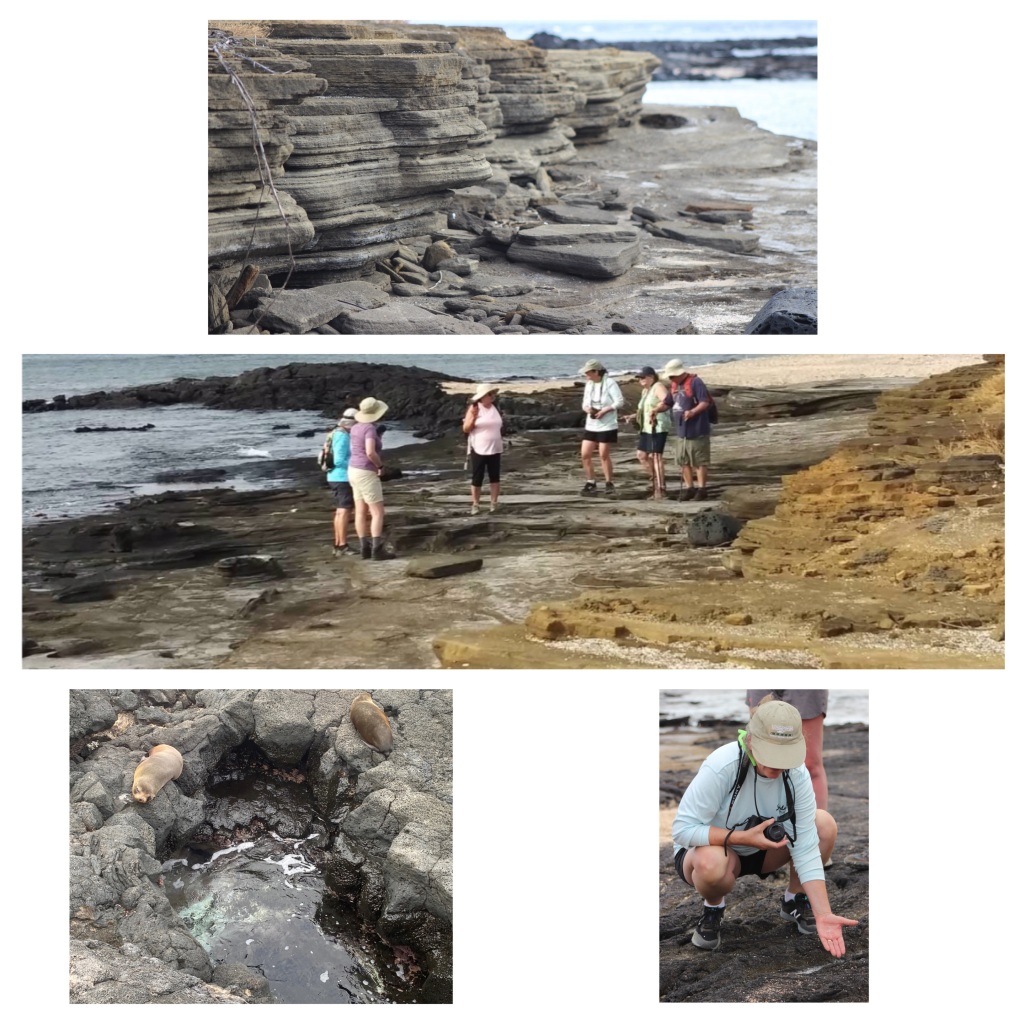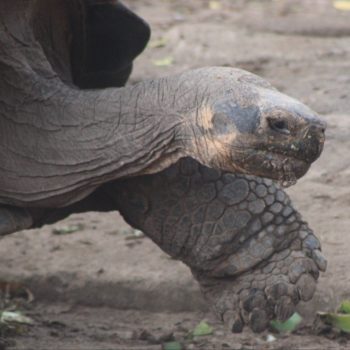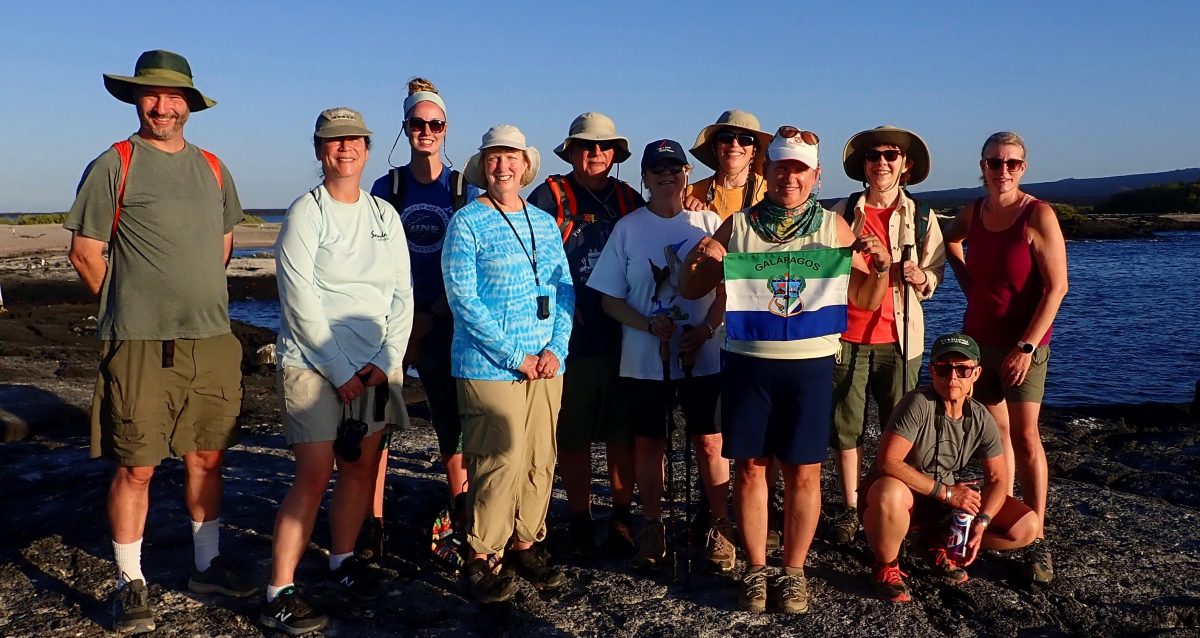
The morning began as we met in the lounge for coffee and suddenly, Lynn spotted a pod of dolphins! LuLu yelled, “get in the pangas”, – we grabbed our life jackets and were off to follow the dolphins. They “played with us” coming right up alongside the pangas, surfacing and going under us- it was exhilarating!


What a fun, spontaneous way to start the day! After breakfast we motored around Bucanero Cove in the pangas to observe birds and sea lions. In the 17th and 18th centuries, Buccanero Cove was a stopping point for pirates, whalers, and Charles Darwin’s expedition to stop for repairs, freshwater, and tortoises for food. We went in and out of small caves in the cliffs. The water was crystal clear and we could see the sea turtles and sea lions swimming around us and lots of fish and red sea stars! Excited to see our first blue-footed boobies along with pelicans, brown noddies, lava gulls, and magnificent frigate birds soaring overhead. What looks like bare rock from a distance is teeming with life in its nooks and crannies. LuLu pointed out the formation called “Bishop Rock” (with its pointed bishop hat and hands folded as if in prayer) and near that is another rock formation that looks like an elephant if you use your imagination.

Approaching a large “white rock” promontory which we saw from a distance, we could now see that it was covered with guano. Colonies of Nazca boobies (formerly called the masked bobbie but renamed for the Nazca tectonic plate) and brown noddies occupied the cliffs.

We headed back to the Bonita where we were greeted with cold drinks and a snack and Steven’s lively playlist on the boombox. Roxanne and Steven showed us the moves- perhaps we should call this the Bonita Boogie! (Check out the video link-science teachers sure do know how to have fun!)

There was free time before lunch to kayak or paddle board around the cove. Interesting to see how the crew rigged up the “train of kayaks” to the pangas.

After a delicious lunch of Wahoo fish, we took the pangas to Espumilla Beach for our first snorkel. For some, this was their first time snorkeling. We were assigned our gear bags for our masks, snorkels and fins, and some instruction on snorkeling from Lulu. We landed on a sandy beach with ghost crabs scurrying away in all directions, and a nest of raucous, hungry baby pelicans waiting for their Mom to feed them. Off we went into the water with Lulu pointing out things to see. For me the big thrill was when Lulu pointed out a four foot white tipped reef shark cruising by and I was able to follow it for a short distance! We saw yellow-tailed surgeon fish, chocolate chip sea stars, parrot fish, and lots of schools of small fish.

After the snorkeling we got back on the Bonita to cruise to Egas Point. Egas Point was once the site of a salt mine. We made a wet landing on the black sand beach and were excited to see colonies of the marine iguanas sunning on the lava rocks and a nursing sea lion with her pup.

After drying off our feet and putting on our hiking shoes, we were ready to hit the trail that goes into the interior of the island and out to the rocky coast. With the view of the Bonita in the distance, we set off on the inland trail, spotting flora and fauna along the way: lantana (with white flowers), croton (LuLu’s Christmas tree), yellow cordia lutea, Galapagos mockingbirds, Medium ground finches, land iguanas, opuntia cactus trees, painted locusts, Galapagos scorpion, and more.

The inland trail led to the rocky coast and what a surprise! Colonies of marine iguanas everywhere. What an opportunity to see these unique reptiles up close, sunning, swimming, and climbing out of the sea. Marine iguanas are found only in the Galapagos, no where else in the world. They are vegetarians, feeding underwater on marine algae. They blend in with the volcanic rocks and when dry, you can actually see colors of red and tan as well. They have lips that look like they are smiling!

The rough volcanic rock made walking challenging in some areas. You could see the broken up plates of lava. There were numerous tide pools, grottos that formed deep pools where the Galapagos fur seals hung out, and basins where rushing seawater flushed in and out through lava tubes. We tasted the sea salt evaporated in the rock indentations.

In one of the grottos we saw several Galapagos fur seals. At first glance they are hard to tell from Galapagos sea lions. They are smaller, have a lusher coat, a shorter snout, and their ears stick out more than the flatter sea lions’ ears. Unlike the sea lions we have seen sunning on the beaches and rocks, the fur seals prefer the grottos with their caves, nooks, and crannies where they can keep cool from the equatorial sun.

Several birds were spotted including the Galapagos dove, American oyster catcher, yellow warbler, lava herons, whimbrels, pelicans, ruddy turnstones, and the rocks near the shore were covered with colorful Sally lightfoot crabs.

Before hiking back to the Bonita, we had our first meditative moment. LuLu had us find a quiet place to sit and for ten minutes we sat in silence, no talking, no photo taking, just observing, listening, and taking in the view of this amazing spot on Earth. It truly made us stop and appreciate how grateful we were to experience this unique and special place where humans and animals can exist in harmony with one another in a modern world in which humans have disrupted natural ecosystems

As we hiked back to meet the pangas, with a lovely view of the Bonita resting at anchor, the sea lion mother and her pup were still in the same spot. And the sun set on another beautiful Galapagos day!

After dinner we assembled in the lounge to receive our “blue feet.” Page and Joyce ordered socks from the Blue Feet Foundation, a non-profit started by a fifth grader to raise funds to support research on the Galapagos to protect the blue footed booby. The socks are made in Ecuador from organic cotton- a wonderful story of how a student learned about blue footed boobies in his science class and started a world-wide project to support them. Our photo will show up on the Blue Feet Foundation web site and is currently on their Instagram page. We all wore our blue feet while LuLu did our briefing for the next day and gave us an overview of Galapagos geology. And now we can measure up to our cabin attendant, Jesus, who wears penguin socks!

Another remarkable day in a Pacific paradise!

